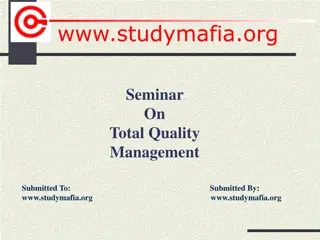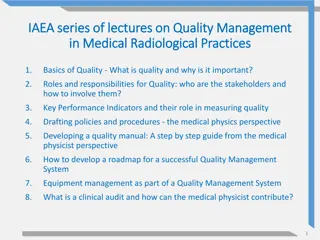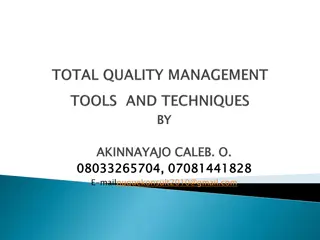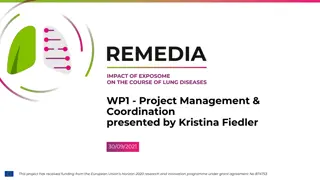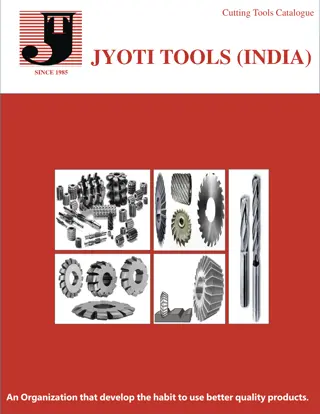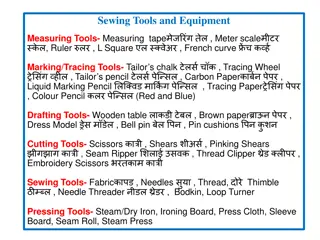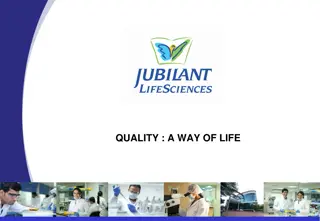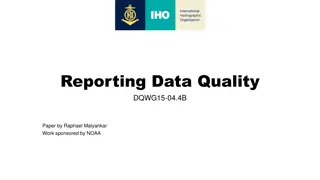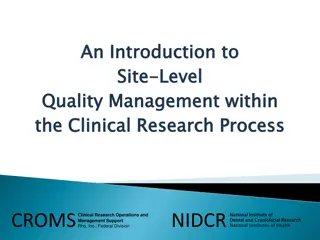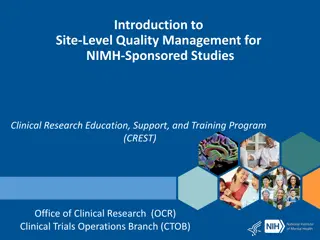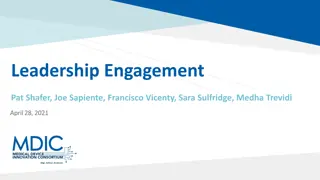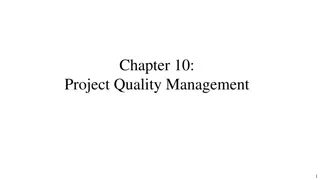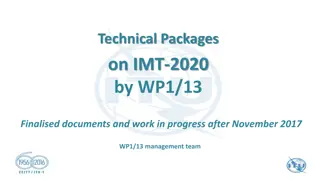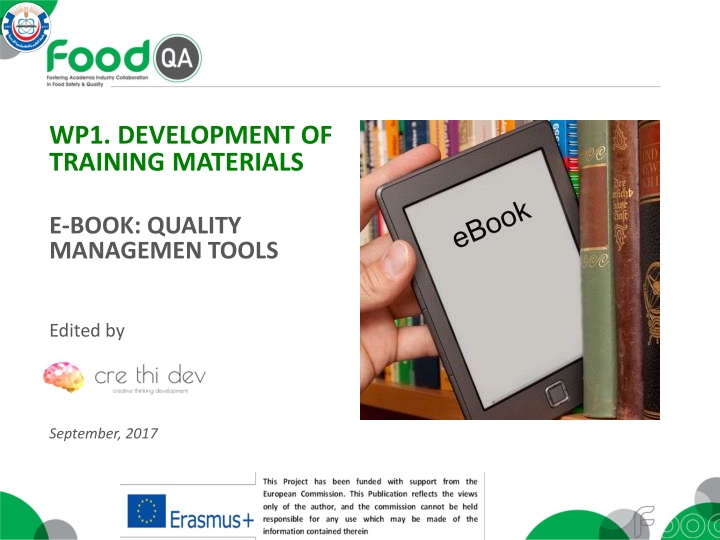
Quality Management Tools E-Book Development Highlights
Dive into the detailed development process of an e-book focused on quality management tools, including key objectives, team collaboration, steps involved, and distribution tasks. Explore the vital role of quality management in enhancing various industries.
Download Presentation

Please find below an Image/Link to download the presentation.
The content on the website is provided AS IS for your information and personal use only. It may not be sold, licensed, or shared on other websites without obtaining consent from the author. If you encounter any issues during the download, it is possible that the publisher has removed the file from their server.
You are allowed to download the files provided on this website for personal or commercial use, subject to the condition that they are used lawfully. All files are the property of their respective owners.
The content on the website is provided AS IS for your information and personal use only. It may not be sold, licensed, or shared on other websites without obtaining consent from the author.
E N D
Presentation Transcript
WP1. DEVELOPMENT OF TRAINING MATERIALS E-BOOK: QUALITY MANAGEMEN TOOLS Edited by September, 2017
WP1. DEVELOPMENT OF TRAINING MATERIALS WP1. DEVELOPMENT OF TRAINING MATERIALS Training materials have two main objectives: 1. To support the development of training courses by FoodQA centres. 2. To provide the industry with training materials that can be used or accessed to provide internal training to their staff. These training materials will be used for the training of the students, technical workers in the food industry and all other workers in the field of food industry and technology. E-BOOK: Quality Management Tools
TEAM E-BOOK: QUALITY MANAGEMENT TOOLS TEAM CRETHIDEV: LEADER Organisation name Country Collaborator P1 Jordan University of Science and Technology (JUST) JORDAN Prof. Majdi Al-Mahasneh P4 Al- Balqa' Applied University (BAU) JORDAN Ihab Ghabeish P6 The Jordan Food and Drug Administration (JFDA) JORDAN Safa Al-Smadi P11 Agricultural University of Athens (AUA) GREECE Nestor Papanikolaou E-BOOK: Quality Management Tools
STEPS Ghantt chart Steps March April May June July August Communication among all the partners involved Preparation of the contents of the e-book Comments and suggestions by partners involved, Final approval and finalization of the contents Distribution proposal of the contents and page numbers - final approval by all partners Implementation of contents Corrections, Development and finalization E-BOOK: Quality Management Tools
STEPS Contents Distribution TASKS DISTRIBUTION 1. Basic Quality Concepts CRETHIDEV 1.1. Basic Quality Definitions CRETHIDEV 1.2. History of Quality Control and Improvement CRETHIDEV 2. Statistical Quality Control CRETHIDEV 3.10. Control Charts JUST 2.1. Statistics used in Quality CRETHIDEV 3.10.1. Control charts for variables JUST 2.2. Statistical Process Control AUA 3.10.2. Control charts for attributes JUST 2.3. Acceptance Sampling AUA 3.11. Process capability (capability indices) JUST 3.12. Value analysis- -Value engineering BAU 3.12.1. Value Analysis BAU 3. The main Quality Tools AUA 3.12.2. Value Engeneering BAU 3.1. Introduction AUA 3.13. Value stream mapping (VSM) BAU 3.2. Check Sheets AUA 3.14. Quality costs 3.14.1. Total Quality Cost BAU 3.3. Run charts AUA BAU 3.4. Histograms JFDA 3.14.2. Conformance Cost A. Prevention Cost B. Appraisal Cost 3.14.3. Non conformance costs A. Internal Failure Cost B. External Failure Cost BAU 3.5. Scatter Diagrams JFDA 3.6. Pareto Charts JFDA 3.7. Flowcharts JFDA BAU 3.8. Cause and Effect (fishbone) Diagrams JFDA 3.9. Design of Experiments (DoE) JUST E-BOOK: Quality Management Tools
IMPORTANCE Importance of Quality Management An important characteristic of the food industry is that, in order to cope with market needs as well as legal requirements, it has to satisfy both safety and quality criteria for it products. Food quality is one of the most complex concepts because it can be assessed only in relation to food safety. A food must meet: legislative, technological, and hygiene requirements, as well as transport and handling requirements, and to satisfy its intended use. The food producers must select and implement: an efficient quality management and food safety system; within this or these systems they must employ quality principles and methodologies, and advanced quality improvement techniques requiring the use of statistics. E-BOOK: Quality Management Tools
PURPOSE Purpose of Quality Management Tools e-book The purpose of this e-book is to assist food producers, distributors, vendors and regulators, of different backgrounds and experiences, in finding information about quality improvement techniques using statistics in order to guarantee the production and distribution of quality and safe food products. E-BOOK: Quality Management Tools
CHAPTERS Quality Management Tools e-book includes three chapters: 1) The basic concepts supporting quality and a brief enlightening history behind the idea of quality ( Basic Quality Concepts ) 2) a description of the statistical background required to understand and employ the quality tools ( Statistical Quality Control ) 3) and a description of the most important quality tools used in production ( The Main Quality Tools ). E-BOOK: Quality Management Tools
BASIC QUALITY CONCEPTS 1. BASIC QUALITY CONCEPTS Chapter Objectives: In this chapter we give the basic definitions of quality, quality improvement, and other quality terminology. We also discuss the historical development of quality improvement methodology and overview the statistical tools essential for modern professional practice. E-BOOK: Quality Management Tools
STATISTICAL QUALITY CONTROL 2. STATISTICAL QUALITY CONTROL Chapter Objectives: In this chapter we present the ideas supporting the Statistical Quality Control, i.e. the basic statistical notions and methodology used for Quality. Furthermore we present a definition and description of Statistical Process Control, as well as for Acceptance Sampling. E-BOOK: Quality Management Tools
MAIN QUALITY TOOLS 3. THE MAIN QUALITY TOOLS Chapter objectives: In this Chapter we will present the Tools of Quality, starting with the 7 basic tools: Cause-and-effect diagram Check sheet Control charts Histogram Pareto chart Scatter diagram Flowchart as well as some less famous but equally useful tools: oValue Analysis - Value Engineering oValue Stream Mapping (VSM) oQuality Costs oDesign Of Experiments (Doe) E-BOOK: Quality Management Tools
Thank you for your kind attention Thank you for your kind attention Creative Thinking Development NON-PROFIT COMPANY E-BOOK: Quality Management Tools

